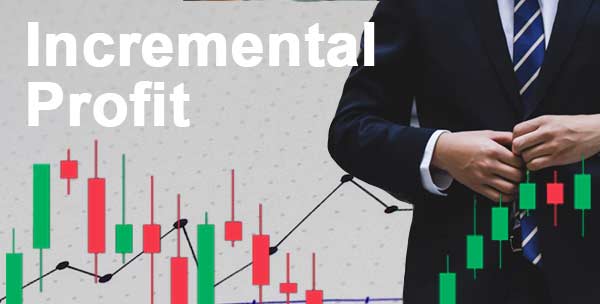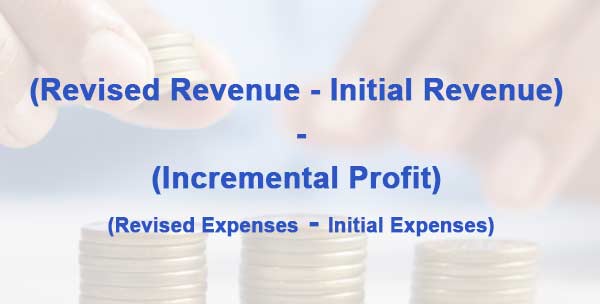
Incremental profit is the monetary gain or loss that results from a specific administrative decision. Total profit increases when incremental profit is positive; total profit decreases when incremental profit is negative. For example, a company might decide against subleasing additional warehouse space for $5000 per month since it believes the cost to be $7500 per month. The profit a company can make by selling one more unit of its goods is an incremental profit. No matter how many or how much you've previously sold, the sum rises every time you sell a new unit; the only factors that matter are how many and how much they cost.
Because it shows an increase in both revenue and costs, it is referred to as 'incremental' growth. For instance, if a business sells 100 units of product A and makes $100 in revenue for each unit, it will also spend $100 in costs associated with manufacturing. Their total revenue will be $300 ($1000 - $100 = $300) if they subsequently sell 100 more units of product A for $200 each (a 30% increase). However, there are still two options for using this increased profit: either as additional income for shareholders or as capital to expand the company's manufacturing capability, allowing it to keep generating more revenue by selling more products.
An income statement, a type of financial report, shows a company's expenses and profits over a specified period of time. Along with the net profit generated during that period, the income statement lists all of the receipts, payments, and expenses made during that period. The income statement is one of the financial statements that a company must prepare in order to provide a trustworthy picture of its financial health. The balance sheet, which identifies the assets, liabilities, and equity of the company at a particular point in time, and the statement of cash flows, which describes how much money entered or left the company during that time period, are the other two. The earnings statement and profit and loss statement are additional names for the income statement (P&L). The P&L includes a breakdown of a company's sales, costs, and net profit for a specific time frame. ordinarily one year.
The total sum of money a business earns from its clients is known as revenue. It is made up of sales tax, supplier discounts, and supplier rebates, and it is derived from the sale of goods and services. Sales and turnover are other terms for revenue.
The incremental profit is, in other words, the difference between costs and revenues. The incremental profit formula is used to calculate the profit that arises from a change in a company's inputs. It is widely employed to determine the impact of changes to costs or revenue on the overall profit margin. The potential revenue your business may produce if you made a change, like adding additional employees or launching a new product line, can also be calculated using the incremental profit formula. The incremental profit approach can also be used to determine how much money would be lost by your business if you made a change, such as getting rid of a product line or an employee. The approach is useful for comparing diverse circumstances, such as launching a new product line or expanding staff. You may use it to figure out which result would be the most profitable for your business. To evaluate how changes in sales or expenses might impact your overall profit margin, use the incremental profit formula. You may determine how much money you would make, for instance, if your typical customer spent an extra $5 on each purchase, using the incremental profit formula. By using this method, you can also determine whether it would be profitable for your company to think about lowering prices by 10% in an effort to attract more customers.

The incremental profit formula is as follows: (Revised Revenue - Initial Revenue) - (Incremental Profit) (Revised Expenses - Initial Expenses).
This serves as an example of how selling one additional unit of a company's goods may increase its profit. The algorithm just displays the potential earnings from each additional sale without taking into account interest or taxes. For instance, if a business sells one additional item while incurring a $5 cost of goods sold expense, it will generate $5 in revenue. This company will earn an extra $2.50 in revenue if its profit margin is 50%. The equation is particularly helpful when attempting to forecast the future growth of a company's revenue.
This method allows you to calculate the precise number of additional goods or services that must be sold in order to raise revenue by a specific amount. For instance, if the company's cost of goods sold was $5 and it earned $2.50 on each unit sold, it would make an incremental profit of $1 by selling one more. This computation can also be used to decide if a company should buy new machinery. You can calculate exactly how much more money can be made by adding one extra unit if you know the sales and cost of goods sold costs for each unit.
If the additional revenue from selling one more unit is more than the cost of doing so, it can be profitable to invest in new equipment. For instance, a company will make $5 in revenue if it sells one more item while paying a $5 cost of goods sold expense. If this company's profit margin is 50%, it will gain an additional $2.50 in revenue. When attempting to predict the prospective growth in a company's revenue, the equation is especially useful.
While computing sales, both incremental revenue and marginal revenue use different sales volumes. For instance, to finish a year-end sales total, a vehicle manufacturer could want to keep track of the marginal revenue from the sale of one more car.
The incremental profit business growth strategy emphasizes making little changes and experimenting with new concepts to build your firm. Instead of aiming for perfection, it's critical to continuously make progress.